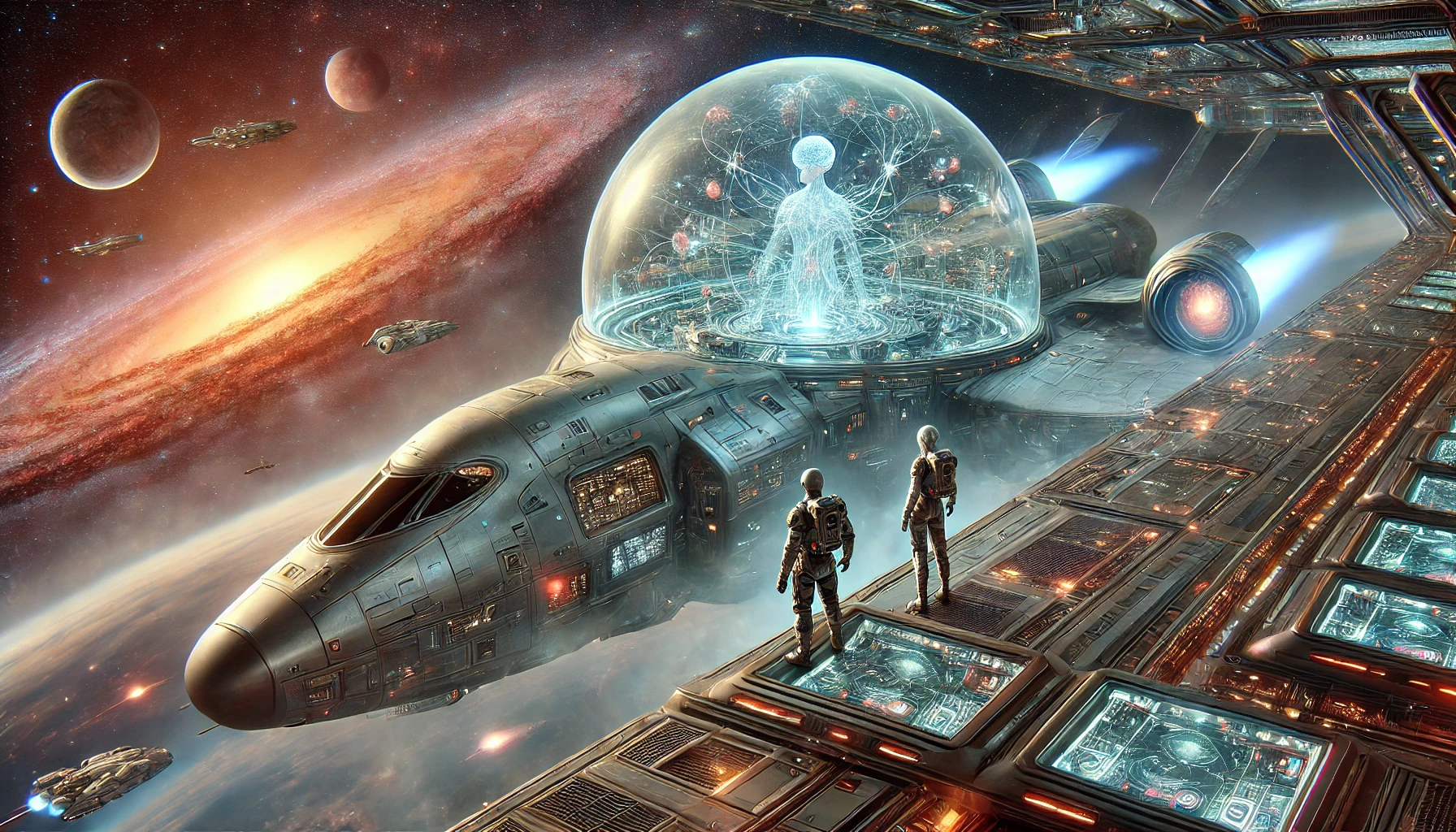In The Disintegration Machine, published in 1928, Arthur Conan Doyle brings back his formidable character, Professor Challenger, in a story that merges scientific wonder with moral ambiguity. The plot follows Challenger and his journalist companion, Edward Malone, as they encounter Theodore Nemor, an enigmatic inventor with a machine capable of disintegrating and reassembling matter at will. This story blends science fiction with ethical dilemmas, as Nemor’s invention poses a profound threat if used for power rather than progress.
Plot Summary
In the autumn chill of a London morning, Professor George Edward Challenger’s study bore witness to his formidable wrath. The renowned scientist, whose brilliance was matched only by his volatile temper, had been interrupted by the incessant ringing of the telephone, leaving him thoroughly disgruntled. Edward Malone, a correspondent from The Gazette, approached him with care, presenting an urgent request from his editor: investigate the invention of a certain Theodore Nemor, a Latvian inventor who claimed to have created a machine capable of disintegrating and reassembling any object, living or inanimate. Fascinated and flattered by the summons, Challenger readily agreed to accompany Malone, his curiosity piqued by the revolutionary implications of such a device.
At Nemor’s flat in Hampstead, Malone and Challenger found themselves awaiting entry as their host dismissed a group of Russian visitors, men of evident wealth and intelligence, hinting at Nemor’s broad influence. When Nemor finally appeared, his unsettling presence filled the room: his thick, compact form, a visage marred by blotches and warts, and a cunning glint in his yellow, cat-like eyes gave him an aura of both intelligence and malevolence. As he greeted Challenger and Malone with obsequious charm, he confirmed his invention’s purpose and potential, explaining it could disintegrate matter into atoms and reassemble it with precision. A machine of this nature, Nemor suggested, could alter global power, making him an object of desire among those hungry for influence.
Challenger, skeptical yet intrigued, demanded a demonstration. Nemor, seizing upon the professor’s challenge, boasted that his model, though a fraction of the intended scale, worked flawlessly and would serve as proof. He gestured toward the apparatus: a chair atop a platform of zinc, with a burnished copper cap suspended above it, each piece connected by heavy copper wires. He invited Challenger to test it himself. Indignant at the implied doubt in his courage, Challenger moved toward the chair, ready to prove his mettle. However, it was Malone, ever cautious and concerned for his friend’s safety, who ultimately took the seat, resolute in testing the machine first.
The lever clicked. Malone’s form flickered, wavered, and vanished, leaving an empty chair. Challenger’s usually unshakeable composure faltered as he stared at the spot where his friend had been, stunned at the machine’s capabilities. After a few moments, Nemor reversed the lever, and Malone reappeared, dazed but unharmed. Challenger, regaining his poise, marveled at the machine’s power while steeling himself to take his turn. He was determined to experience the effects himself, and with a calm resolve, seated himself upon the chair.
Nemor, savoring Challenger’s readiness, adjusted the lever. Challenger disappeared, just as Malone had, his large frame dissolving into a mist of molecules. Nemor smiled at Malone, clearly reveling in his control over such a powerful figure. To Malone’s alarm, Nemor mused about leaving Challenger in his suspended state or altering his reassembly—a reminder of the dangers such power placed in the hands of a man like Nemor. When Challenger reappeared, however, it was a strange, altered figure: his formidable mane was gone, leaving him bald and vulnerable, transformed from a proud lion to an oddly exposed figure.
Challenger’s hand flew to his head, his dismay quickly turning to fury as he realized Nemor’s mockery. With unrestrained rage, he seized the smaller man by the throat, shaking him in an iron grip until Malone’s pleas brought him back from the brink of violence. Pale and trembling, Nemor stammered apologies, claiming his actions were mere jest to demonstrate the machine’s full capabilities. Challenger, still bristling, ordered Nemor to restore him completely, or suffer the consequences. Scarcely able to hide his terror, Nemor quickly complied, and with a twist of the lever, returned Challenger to his full, fearsome form.
Once restored, Challenger, his voice firm, pressed Nemor on the machine’s mechanism and the exact nature of its power. Nemor, though evidently shaken, explained that only he alone held the complete knowledge required to operate the device, and that he worked without assistants, holding this knowledge within his mind—a far more secure safeguard, he claimed, than any written record. Nemor further elaborated that the current machine was merely a model, while a full-scale version could act horizontally as well, unleashing devastating consequences on a larger scale. Ships, columns of soldiers, even entire city districts could be reduced to dust and reassembled, or left dispersed forever. Nemor revealed that he had already struck a deal with a foreign power, ensuring their monopoly over this technology—a force, he hinted, that could wipe out entire populations with terrifying ease.
This pronouncement sent a chill through Malone, who felt the malice woven through Nemor’s words. Challenger, however, responded differently. His tone softened as he congratulated Nemor on his ingenious harnessing of natural forces, expressing admiration for Nemor’s scientific achievement, though the professor maintained that he did not condone the machine’s potentially destructive applications. Challenger’s measured response concealed a shrewd plan; he showed interest in examining the machine’s internal mechanics, all the while subtly maneuvering himself to gain control of the device.
As Nemor seated himself in the machine once again to check for electrical leakage, Challenger deftly moved his hand to the lever, activating the disintegration function. In a flash, Nemor vanished into nothingness, his smug expression replaced by a look of pure astonishment in the final instant before his form dissolved. Malone, watching in horror and confusion, turned to Challenger, who casually explained that he might have accidentally engaged the wrong lever. Challenger mused aloud that with the machine’s complex setup, finding the precise lever to reverse Nemor’s disintegration might be challenging, if not impossible. His tone suggested a calm acceptance of this “error.”
Thus, Theodore Nemor’s essence scattered into the ether, leaving his machine an inert, silent reminder of its terrible potential. Challenger’s measured expression softened as he reflected on the morning’s events, concluding that Nemor’s ambition would no longer haunt the world. As they prepared to leave, Challenger, ever the man of science, commented to Malone that their investigation had borne unexpected fruit; a terrible threat had been neutralized. With their solemn task complete, Challenger returned to the smaller concerns of scientific debate, unfazed by the experience as he planned his rebuttal to a rival’s theory on tropical termites, undeterred by the unsettling power he had encountered and so casually dismantled.
Main Characters
Professor George Edward Challenger: A renowned scientist with a lion-like personality, Professor Challenger is known for his imposing intellect and explosive temper. His unyielding confidence in science and rationality propels him to investigate Nemor’s invention, while his quick temper adds tension and urgency to the narrative.
Edward Malone: A dedicated journalist working for The Gazette, Malone is sent to cover Nemor’s invention alongside Challenger. His cautious nature contrasts with Challenger’s brazen confidence, and his sense of responsibility often acts as a moral counterbalance to Challenger’s zeal.
Theodore Nemor: A mysterious Latvian inventor, Nemor is shrewd and cunning, with a mind for groundbreaking technology and a penchant for manipulation. His disintegration machine, and his willingness to use it as a weapon for the highest bidder, establish him as a morally dubious figure driven by ambition.
Theme
The Power of Science: Central to the story is the exploration of science as both a tool for progress and a potential threat. Challenger’s interest in Nemor’s invention represents science’s unyielding curiosity, yet the machine’s destructive potential raises questions about the ethical limits of scientific advancement.
Moral Responsibility: The characters face a dilemma over Nemor’s disintegration machine, a tool that could easily become a weapon. This theme highlights the moral responsibility that accompanies technological power, especially when it can alter the balance of global power.
Human Curiosity vs. Ethical Boundaries: Challenger’s eagerness to test the machine, even on himself, contrasts with Malone’s skepticism. Their dynamic reflects the tension between curiosity and caution, challenging readers to consider where humanity should draw the line in its pursuit of knowledge.
Writing Style and Tone
Arthur Conan Doyle’s writing in The Disintegration Machine combines a formal, intellectual tone with wry humor and sharp dialogue, especially between Challenger and Malone. Challenger’s grandiose language and abrupt mannerisms create a character who both fascinates and intimidates, reflecting Doyle’s skill in rendering larger-than-life personalities. The narrative’s pacing is brisk, with vivid descriptions that draw readers into the suspense of Nemor’s experiment.
Doyle’s approach seamlessly integrates science fiction with speculative, almost philosophical elements. His language is precise, and he carefully frames the moral dilemmas surrounding technology with a balance of curiosity and caution. By setting a quick tempo and intertwining Challenger’s brash personality with Malone’s grounded pragmatism, Doyle crafts a narrative that is both entertaining and thought-provoking, leading readers to ponder the ethical considerations of unchecked scientific power.
We hope this summary has sparked your interest and would appreciate you following Celsius 233 on social media:
There’s a treasure trove of other fascinating book summaries waiting for you. Check out our collection of stories that inspire, thrill, and provoke thought, just like this one by checking out the Book Shelf or the Library
Remember, while our summaries capture the essence, they can never replace the full experience of reading the book. If this summary intrigued you, consider diving into the complete story – buy the book and immerse yourself in the author’s original work.
If you want to request a book summary, click here.
When Saurabh is not working/watching football/reading books/traveling, you can reach him via Twitter/X, LinkedIn, or Threads
Restart reading!








